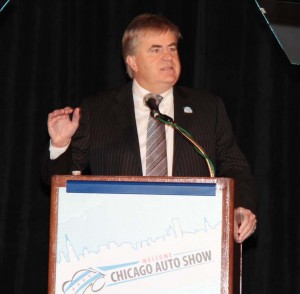
Toyota Vice President Bob Carter is focusing on the expected surge in demand for new vehicles this year.
The recovery of the U.S. auto market is likely to slow in 2014 – but Toyota Vice President Bob Carter said he’s focusing on the half-full view of the glass, noting that the coming year will still bring another surge in demand, marking the first time since the 1930s that American automotive sales increased for five consecutive years.
Carter, who oversees the Japanese giant’s U.S. automotive operations, offered a generally upbeat assessment of the status of both the car business and Toyota itself during an appearance marking the opening of the 2014 Chicago Auto Show. Among other things, Carter said repairs have begun on more than 30,000 Toyota vehicles that were pulled from sale last month due to a defect in their seat heaters. They should be back on sale in a matter of weeks, he explained.
Exactly what 2014 will bring is a matter of some debate – especially after the industry’s lackluster performance in January that saw a number of key makers, General Motors and Ford, lose ground. Toyota posted a 7.2% dip, year-over-year. That was a disappointment for those who hoped to see the market maintain the pace of 2013 when sales jumped by more than 1 million units, to 15.6 million, the best tally since before the recession.
Nonetheless, Carter suggested January’s devastating weather was a factor, and that the market will likely get back on track, albeit at a “slower pace” than last year. Toyota is working under the assumption that U.S. sales will reach somewhere north of 16 million for all of 2014.
While so-called pent-up demand – from buyers who postponed purchases during the recession – has largely dried up, the executive said other factors, including stronger economic growth and “historically low” interest rates will keep momentum going. He also noted the flood of new products coming from Toyota and its competitors “which act like a magnet to bring customers into showrooms.”
If Carter and other analysts are right and 2014 does reach 16 million or higher, it would mark an eight-decade milestone, he said, noting “The industry has not seen five consecutive years of sales growth since the 1930s.”
Toyota itself is anticipating it will sell 2.3 million vehicles in the U.S. in 2014, a 100,000-unit increase year-over-year, the maker’s slow start not withstanding.
Part of the problem in January was the decision to order a stop-sale on vehicles sold in the U.S. equipped with electric seat heaters due to a supplier’s use of improper seat materials. In all, more than 30,000 Toyota products have been sidelined – which includes anywhere from 30% of the Camry models on dealer lots to 100% of the full-size Avalon models.
Carter noted that the parts needed to repair those vehicles are now flowing into dealer service departments and repairs should be completed in a matter of weeks. He suggested the overall impact on February sales, meanwhile, will be “inconsequential.”
(Toyota goes to extremes with new TRD trucks. For more, Click Here.)
But the issue may not be concluded quite so quickly. Federal regulators are investigating whether a recall is required for vehicles already in customer hands equipped with the faulty seat heaters. While Toyota is clearly trying to avoid that step, Carter said it is “NHTSA’s decision.”
The maker is clearly aware that it has to take a cautious approach on any potential safety issue considering the problems it experienced a few years back related to so-called unintended acceleration. It ultimately paid tens of millions of dollars in fines for failing to act on several safety issues in a timely matter.
(Click Here to see the Limited Edition Camry Toyota is spinning off.)
On a more positive note, Carter told reporters that Toyota is continuing to ramp up exports from its American assembly plants, particularly of models primarily designed for the U.S., like the big Tundra pickup, that might generate a following abroad. In all, it exported 130,000 vehicles in 2013 and anticipates that growing this year with the addition of the Highlander Hybrid model that will be produced in the States.
Carter noted that Toyota’s expanding North American production base – with 14 assembly lines – accounts for 70% of the vehicles now sold in the U.S. And that shows that it is not focused on imports in order to take advantage of favorable dollar/yen exchange rates.
(To see how Toyota topped the recent brand perception survey, Click Here.)
“We do not manage our business on currency,” he insisted, though analysts note that favorable exchange rates accounted for roughly half of the Japanese giant’s $5.2 billion profit for the final quarter of 2013.

Everything could change in a heartbeat if the Chinese economic collapse crushes economies world wide and it might. With the PC industry in the U.S. eliminating 50,000 more jobs in the past few weeks, it’s difficult to believe the U.S. economy is making steady progress when these companies have already eliminated hundreds of thousands of U.S. jobs over the past 5 years.